Ship Husbandry > Underwater Propeller Polishing
Pacific Blu Subsea Services
Underwater Propeller Polishing
Before Cleaning
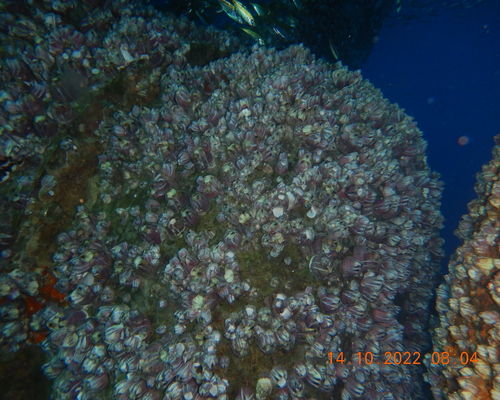
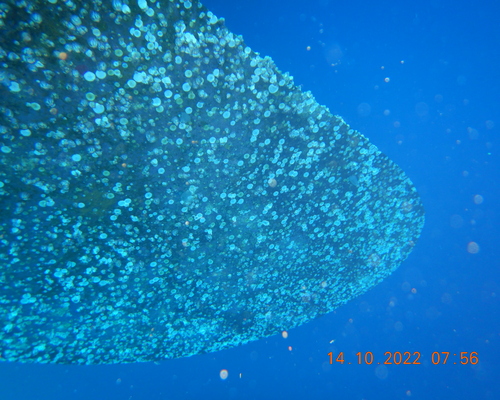
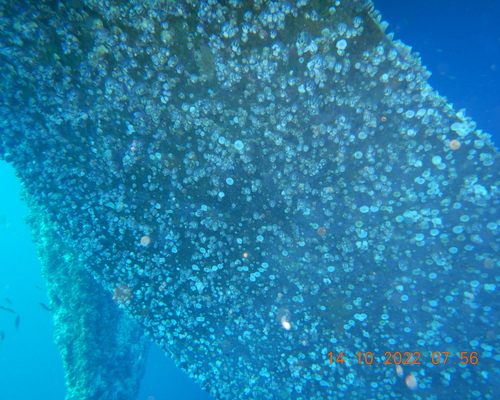
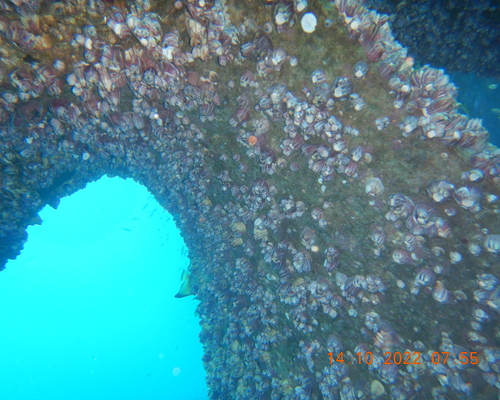
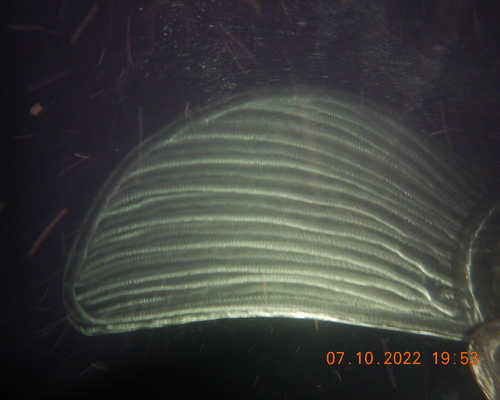
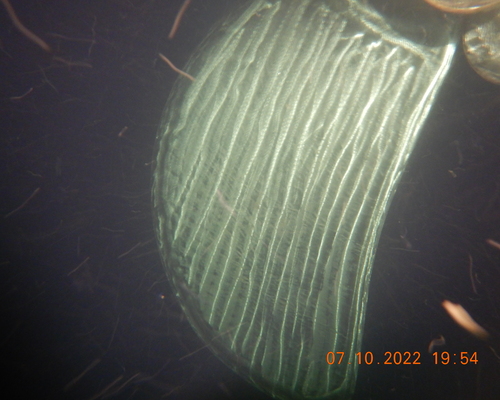
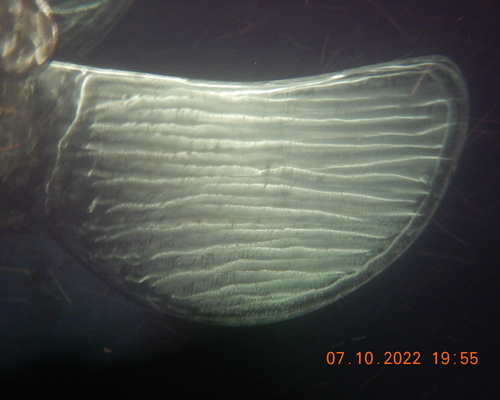
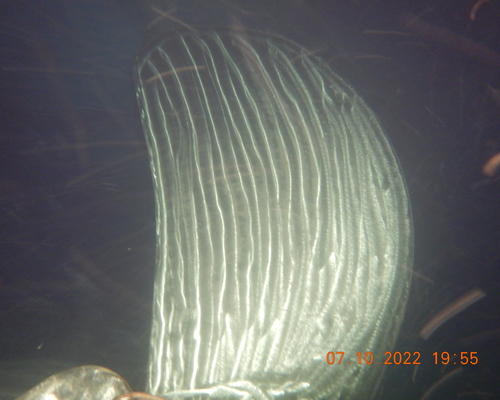
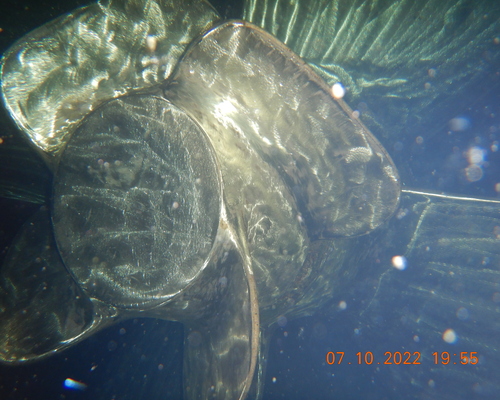
After Cleaning
The Function of Propeller
The propeller blade works much like an air-foil, developing thrust as a result of the pattern of flow around the blade. As the propeller turns, the blades create a pressure differential in the water which propels the ship forwards or backwards depending on which way the propeller is turning and/or the pitch of the blades (either fixed or variable pitch).
Importance of Propeller Cleaning and Polishing
An important problem in shipping is the increase of roughness to the ship’s propeller, as the fuel consumption and the emission of gaseous pollutants in the environment is increased and significant losses are caused to the propulsion system.
The intent of underwater propeller polishing is to reduce the surface roughness. A smooth propeller surface can be inhospitable to marine organisms and enhances the efficiency of the propeller, in turn optimising the vessel’s performance. The rough propeller leads to power loss, which can be up to 6% as well as an increase of fuel consumption
Although the surface area of the propeller is minuscule when compared to that of the entire hull, the effects of a rough propeller on the vessel’s fuel consumption is comparatively large. On the other hand, the cost of remedying a rough propeller compared to that of remedying a rough hull is very slight.
What Causes Propeller Roughness?
The following causes may work in concert, with each source of roughness complementing the others and accelerating the decline in overall smoothness of the propeller.
Fouling
Marine pollution and fouling such as algae and other marine elements accumulate on the surface of the propeller. It is expected that any condition, such as roughening of the surface by fouling, which disturbs the flow pattern will have a marked effect on the development of propulsive force.
It may be supposed that roughness of a grosser sort occasioned by fouling will produce much greater losses in efficiency. The extent of fouling which can occur on propellers and also of the vagaries of propeller fouling which can be attributed to the hydrodynamics of the rotation of the propeller and its shape. Many organisms may be found fouling the propellers of active vessels. They include algae, barnacles, tubeworms, molluscs, and encrusting bryozoa.
Manufacture
The material used to make the propeller can have a significant bearing on the propeller’s smoothness or roughness when new and during service, as can the method and standard of manufacture. Today, propellers are made from bronzes or stainless steels. For the last two to 3 decades, nickel-aluminium bronze has become the material of choice and now accounts for over 80% of the propellers made. Stainless steels (for ice class propellers), high tensile brass (manganese bronze) and manganese-aluminium bronze are used for a small percentage of propellers. Manganese bronze propellers have been found to be considerably rougher than those made of nickel-aluminium bronze.
Calcareous Deposits
After a while in the water, the propeller develops a rough carbonate layer (calcareous chalk), which is a by-product of the cathodic protection system of the ship. Ships usually have sacrificial zinc or impressed current anodes that generate electrons that flow to areas of paint damage on the hull and the propeller and prevent corrosion. This causes the areas of bare metal to become cathodic and in so doing reduce oxygen and water to hydroxyl ions that react with calcium, magnesium and carbon dioxide to form calcium and magnesium carbonates (chalk). The chalk deposits add protection to the surface but also cause significant roughening. The amount, rate and type of deposit is dependent on cathodic current density and ambient seawater conditions. This generally forms faster in tropical waters. The formation of a chalk film cannot occur while a propeller is rotating as it is necessary for the alkali to remain close to the cathodic propeller surface, at which it is formed, long enough to precipitate calcium and magnesium hydroxides, and for these to change to carbonates by absorption of carbon dioxide from the sea water. However, any period of inaction affords an opportunity for a chalk film to form over the whole propeller. In practice this layer of calcareous deposits can be quite hard and time consuming to polish off.
Corrosion
The propeller is subject to chemical/ electrochemical corrosion. Almost all propellers in use are uncoated/ unpainted. The moment the propeller is immersed in water, it becomes the cathode in the hull propeller electrolytic cell. The electrolysis as well as the simple chemical effect of saltwater on the bronze or other alloy, form a dual corrosive source. The electrolytic corrosion ties in with the calcareous deposit.
Impingement Attack
A ship’s propeller travels at relatively high speed through the ocean waters which contain abrasive particles. The impingement attack is caused by these abrasive particles as they meet the leading-edge region of the propeller, particularly the outer tips furthest from the hub, where the speed is highest. Impingement attack results in roughness over a large area of the propeller. As with the other sources of propeller roughness, this roughness is an accelerating downward spiral. The rougher the propeller gets, the more effect the impingement attack has.
Cavitation
Hydrodynamic cavitation is a phenomenon that accompanies turbulent fluids. The turbulence in the fluid, caused by the propeller’s motion through the water, results in areas of greatly reduced fluid pressure. Due to the low pressure, the water vaporizes. This causes small vapor-filled cavities or bubbles in the fluid up to about 3 mm in diameter. The cavities travel through the water and the pressure around them increases, causing them to collapse suddenly. The implosion of the cavities is accompanied by a complex set of physical processes. It is the collapse of the cavities which is accompanied by very high-pressure pulses, speeds and temperatures in the water, that cause the damage to the metal surfaces where this collapse occurs. Cavitation erosion, electrolytic and chemical corrosion combine to multiply the damage to the propeller’s surface and therefore the roughness of the blades.
Mechanical Damage
Mechanical damage can be found in propeller (blades) due to collision with objects that can be found at sea. Due to its position and shape as well as its speed, the propeller is prone to damage from encountering solid objects. Propeller blades can be bent, broken, cracked, scratched, and dented and this will affect the surface smoothness and the fuel efficiency of the propeller.
Improper Cleaning or Polishing
Whether performed in the water or in drydock, poor quality propeller polishing can result in increased roughness. Poor quality grinding may worsen the blade roughness which will in turn cause an increase in high wave number roughness due to scratching of the surface. At the same time, interference with the accurate dimensions of the blade leading edge form can seriously impair performance. During hull painting, a propeller is always subject to splashes of conventional anti-corrosive or anti-fouling paints, which increase the surface roughness of the blade.
Measuring Propeller Roughness
There are various methods of measuring the roughness of a propeller, among which Rubert comparator is most useful. The Rubert comparator is based on a scale of propeller roughness ranging from A (smoothest) to F (roughest). By visual observation and touch, our divers compare various parts of the propeller blades to the samples on the comparator and the roughness of the propeller can be mapped.
The significant advantages of propeller polishing:
The sole purpose of polishing a propeller underwater is to reduce the surface roughness. Removing marine growth and calcium deposits is beneficial to the efficiency of the propeller performance and reducing stress on the propeller shaft and ship’s engines.
Furthermore, underwater propeller polishing may be performed parallel with the underwater hull cleaning. After the procedure, we provide high quality photographic material with data before and after the polishing. The more often that the ship’s propeller is cleaned and polished, the more money is saved due to the reduction of fuel consumption. Therefore, the cost is outweighed for the underwater propeller cleaning and brings profit. Also, another profitable alternative is the combination of underwater propeller polishing with the underwater hull cleaning and general inspection of the ship, which brings even greater economic benefit to our clients. Objectively, the following advantages can be presented of propeller polishing.
- Increase and improvement of vessel’s performance
- Reduced fuel consumption up to a significant extent
- CO2 emission reduction of gases in the marine environment
- Increase in vessel’s speed
- Reduction of unwanted vibrations due to cavitation
- Stress Reduction of the propeller axis and the vessel’s machinery
- The propeller and rudder are cleaned simultaneously, to further enhance the performance of the vessel
- Increased reliability
- Expansion of vessel’s maintenance cycles


